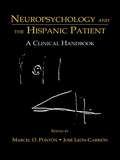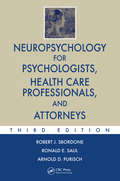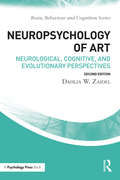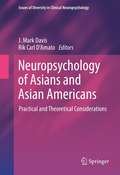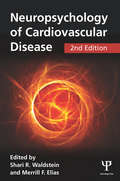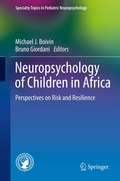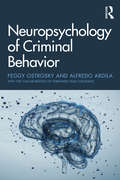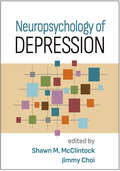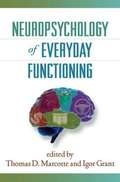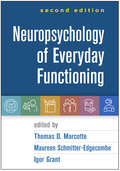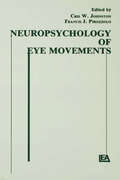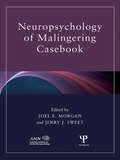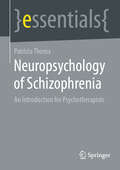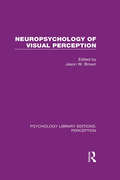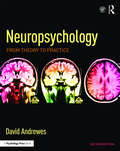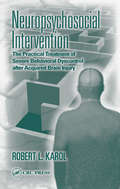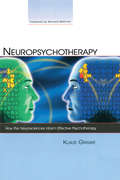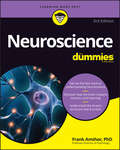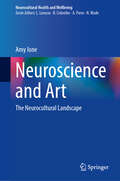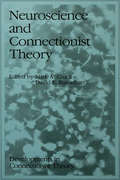- Table View
- List View
Neuropsychology and Substance Use: State-of-the-Art and Future Directions (Studies on Neuropsychology, Neurology and Cognition)
by Ari Kalechstein Wilfred G. van GorpSubstance use continues to be a major public health problem, and the ramifications of this are manifold. For instance, at present, on a yearly basis, the total economic cost of substance misuse is literally hundreds of billions of dollars. These costs are related to a number of factors, including, but not limited to, treatment and prevention, reduced job productivity and/or absenteeism, interdiction by the criminal justice, and incarceration. There are many more psychosocial consequences of substance misuse, and these have been well–documented over the past four to five decades; in contrast, with the exception of alcohol, the effects of substance misuse on the brain have received attention only in the past 10 to 15 years. An emerging body of literature has reported on the effects of various drugs on neuropsychological functioning, including benzodiazepines, cocaine, marijuana, MDMA, methamphetamine, nicotine, and opioids. Despite the fact that the neuropsychological consequences of many drugs of abuse are well–documented, to our knowledge, no one had previously published an edited volume that focused exclusively on this issue. Based on this fact, we decided to create a volume that would review the available literature regarding on this topic. Neuropsychology and Substance Misuse: State-of-the-Art and Future Directions explores cutting-edge issues, and will be of interest to clinical neuropsychologists who require the latest findings in this increasingly important area of neuropsychology.
Neuropsychology and the Hispanic Patient: A Clinical Handbook
by Marcel O. Pontón José León-CarriónBy 2010, 15% of the U.S. population will be Hispanic. Neuropsychology and the Hispanic Patient: A Clinical Handbook brings together internationally recognized authorities to address the cultural, methodological, research, and forensic issues that must be considered by neuropsychologists seeking to be maximally effective in their work with members of the fastest-growing American minority group. It includes: * useful assessment decision trees; * summaries of normative data; * descriptions of tests available in Spanish; * extensive HIV and pediatric references; and * numerous charts and illustrations. Reflecting the latest demographic information and covering the developmental spectrum from pediatric to geriatric, this landmark Handbook will become an indispensable reference tool for clinicians and researchers alike.
Neuropsychology for Psychologists, Health Care Professionals, and Attorneys (Rob & Smith's Operative Surgery Series)
by Robert J. Sbordone Ronald E. Saul Arnold D. PurischExtensively revised and expanded, this third edition of Neuropsychology for Psychologists, Health Care Professionals, and Attorneys provides a clear, concise, and comprehensive discussion of neuropsychology, outlining its purpose, use, and historical development. It covers the anatomy of the brain, a wide variety of neurobehavioral disorders, compr
Neuropsychology of Art: Neurological, Cognitive and Evolutionary Perspectives (Brain, Behaviour and Cognition)
by Dahlia W. ZaidelThe significance of art in human existence has long been a source of puzzlement, fascination, and mystery. In Neuropsychology of Art, Dahlia W. Zaidel explores the brain regions and neuronal systems that support artistic creativity, talent, and appreciation.Both the visual and musical arts are discussed against a neurological background. Evidence from the latest relevant brain research is presented and critically examined in an attempt to clarify the brain-art relationship, language processing and visuo-spatial perception. The consequences of perceptual problems in famous artists, along with data from autistic savants and established artists with brain damage as a result of unilateral stroke, dementia, or other neurological conditions, are brought into consideration and the effects of damage to specific regions of the brain explored. A major compilation of rare cases of artists with brain damage is provided and the cognitive abilities required for the neuropsychology of art reviewed.This book draws on interdisciplinary principles from the biology of art, brain evolution, anthropology, and the cinema through to the question of beauty, language, perception, and hemispheric specialization. It will be of interest to advanced students in neuro-psychology, neuroscience and neurology, to clinicians and all researchers and scholars interested in the workings of the human brain.
Neuropsychology of Art: Neurological, Cognitive, and Evolutionary Perspectives (Brain, Behaviour and Cognition)
by Dahlia W. ZaidelFully updated, the second edition of Neuropsychology of Art offers a fascinating exploration of the brain regions and neuronal systems which support artistic creativity, talent and appreciation. This landmark book is the first to draw upon neurological, evolutionary, and cognitive perspectives, and to provide an extensive compilation of neurological case studies of professional painters, composers and musicians. The book presents evidence from the latest brain research, and develops a multidisciplinary approach, drawing upon theories of brain evolution, biology of art, art trends, archaeology, and anthropology. It considers the consequences of brain damage to the creation of art and the brain’s control of art. The author delves into a variety of neurological conditions in established artists, including unilateral stroke, dementia, Alzheimer’s Disease, Parkinson’s Disease, and also evidence from savants with autism. Written by a leading neuropsychologist, Neuropsychology of Art will be of great interest to students and researchers in neuropsychology, cognitive psychology, neuroscience, and neurology, and also to clinicians in art therapy.
Neuropsychology of Asians and Asian-Americans: Practical and Theoretical Considerations
by J. Mark Davis Rik Carl D'AmatoNeuropschology with Asians and Asian Americans Practical and Theoretical Considerations J. Mark Davis and Rik Carl D'Amato, editors The challenge of cultural competence for health providers is more than the recognition of other ethnicities: it entails the balancing of group and individual factors to apply relevant information in diagnostic and therapeutic settings. Particularly in need of culturally appropriate services are Asians and Asian Americans, populations that are diverse, growing, and underserved by Asian practitioners. Neuropsychology with Asians and Asian Americans takes cultural neuroscience to new levels in its variety and usefulness. Focusing on the largest groups of Far East and Southeast Asian descent, this leading-edge reference examines the influence of culture on psychological processes and identifies sociocultural factors as they influence neurological aspects of client presentation. This expert coverage goes beyond well-known constructs of "collectivism" and "family orientation" toward establishing an evidence base crucial to understanding, assessing, and treating Asian and Asian American clients, including: Linguistic factors and language assessment of Asians.Society and acculturation in Asian and Asian American communitiesMental illness from Asian and Asian American perspectives.Understanding cognitive differences across the lifespan: comparing Eastern and Western culturesClinical interviews and qualitative assessment with Asian clientsNeuropsychological test selection with Asian clients Unique in its scope and detail, Neuropsychology with Asians and Asian Americans is a necessary resource for neuropsychologists and rehabilitation specialists as well as social workers and clinical, counseling, and school psychologists.
Neuropsychology of Cardiovascular Disease
by Shari R. Waldstein Merrill F. EliasCardiovascular disease (CVD) is the leading cause of morbidity and mortality in the United States and most westernized nations. Both CVDs and their risk factors confer substantial risk for stroke and dementia, but are also associated with more subtle changes in brain structure and function and cognitive performance prior to such devastating clinical outcomes. It has been suggested that there exists a continuum of brain abnormalities and cognitive difficulties associated with increasingly severe manifestations of cardiovascular risk factors and diseases that precede vascular cognitive impairment and may ultimately culminate in stroke or dementia. This second edition examines the relations of a host of behavioral and biomedical risk factors, in addition to subclinical and clinical CVDs, to brain and cognitive function. Associations with dementia and pre-dementia cognitive performance are reported, described, and discussed with a focus on underlying brain mechanisms. Future research agendas are suggested, and clinical implications are considered. The volume is a resource for professionals and students in neuropsychology, behavioral medicine, neurology, cardiology, cardiovascular and behavioral epidemiology, gerontology, geriatric medicine, nursing, adult developmental psychology, and for other physicians and health care professionals who work with patients with, or at risk for, CVDs.
Neuropsychology of Children in Africa
by Bruno Giordani Michael J. BoivinIncreasingly, global humanitarian efforts are focusing on improving the lives of children. And among the developing world, the African nations are particularly affected by extreme weather conditions, devastating pandemics, and armed conflict. Neurocognitive science offers significant avenues toward bringing needed aid to the continent while creating a template for helping children worldwide. The studies in Neuropsychology of Children in Africa clearly illustrate how the brain develops and adjusts in the face of adversity. Contributors span assessment approaches and public health risk factors, and represent established topics and emerging lines of research, including biocultural constructs and genomic technologies. Together, these chapters argue for methodology that is culturally sensitive, scientifically rigorous, consistent, and sustainable. And although the focus is pediatric, the book takes a lifespan approach to prevention and intervention, modeling a universal framework for understanding neurocognitive development. Included in the coverage: Assessment of very young children in Africa in the context of HIV.Psychosocial aspects of malnutrition among African children.Assessment of neuropsychological outcomes in pediatric severe malaria.Neurodisability screening using the Ten Questions questionnaire.The neuropsychology of sickle cell disease in West African children.Computerized Cognitive Rehabilitation Therapy for African children. As a guide to current findings or a springboard for new studies, Neuropsychology of Children in Africa is a necessary reference for researchers, policymakers, and diverse professionals in global aid organizations, and across the discipline.
Neuropsychology of Criminal Behavior
by Alfredo Ardila Feggy OstroskyThis book draws on findings from psychology, neurology, and genetics, to offer a multi-dimensional analysis of criminal behavior. It explores the biological bases of emotions such as aggression, anger, and hostility and how they-- combined with social psychological influences, such as family history and environmental conditions-- may lead to violence. Specific case studies, including serial killings, mass murders, family violence, cannibalism, and hitmen, are referenced throughout, providing real-world examples of these theories in action. Issues of free will and the law are discussed as well as suggestions for curbing violent behavior.
Neuropsychology of Depression
by Shawn M. McClintock and Jimmy ChoiTimely and authoritative, this unique volume focuses on neurocognitive aspects of depression and their implications for assessment, evaluation, clinical management, and research. Experts in the field explore the impact of depression on executive function, learning and memory, working memory, and other critical capacities, and present cutting-edge assessment tools and procedures. The neurocognitive effects of widely used antidepressant treatments are reviewed, from psychotropic medications and evidence-based psychotherapies to established and emerging neuromodulation technologies. Practical aspects of working with adults across the lifespan with depression are addressed, including ways to strengthen treatment engagement and adherence, and to incorporate cultural considerations.
Neuropsychology of Everyday Functioning
by Igor Grant Thomas MarcotteWhile neuropsychological testing can accurately detect cognitive deficits in persons with brain injury, the ability to reliably predict how these individuals will function in everyday life has remained elusive. This authoritative volume brings together well-known experts to present recent advances in the neuropsychological assessment of key real-world capacities the ability to live independently, work, manage medications, and drive a car. For each of these domains, contributors describe cutting-edge tests, procedures, and interpretive strategies and examine salient theoretical and methodological issues. Chapters also review approaches for evaluating specific populations, including older adults and patients with traumatic brain injury, depression, dementia, schizophrenia, and other neurological and psychiatric disorders.
Neuropsychology of Everyday Functioning, Second Edition
by Igor Grant Thomas D. Marcotte Maureen Schmitter-EdgecombeThe go-to resource for assessing and predicting functional abilities in persons with brain injury or cognitive decline has now been revised and expanded to reflect significant advances in the field. With a focus on key real-world capacities--independent living, vocational functioning, medication management, and driving--leading experts explore how individuals go about their daily lives, where and why disruptions occur, and potential opportunities for improving function. Strategies for direct assessment are reviewed, from standard neuropsychological tests to multimodal approaches and technology-based tools. Chapters also provide functional assessment guidance for specific neurological and psychiatric conditions: dementia, traumatic brain injury, depression, schizophrenia, and others. New to This Edition *Incorporates over a decade of technological and methodological innovations. *Chapter on theories and models of everyday functioning. *Chapters on naturalistic assessment, wearable sensors, ambulatory assessment, and virtual-reality-based tools. *Practical clinical implications are highlighted throughout.
Neuropsychology of Eye Movement (Neuropsychology and Neurolinguistics Series)
by Francis J. Pirozzolo Cris W. JohnstonFirst Published in 1988. The idea for this book arose from a desire to bring together relevant information from the fields of vision research, neuropsychology, neurology, and psychiatry. The selection of topics covered by N europsychology of Eye Movements conforms to the primary areas of inquiry that currently exist. Unlike the majority of other books on eye movements, which represent proceedings of meetings, this volume is com prised of a number of critical review s of the research literature.
Neuropsychology of Malingering Casebook (American Academy of Clinical Neuropsychology/Routledge Continuing Education Series)
by Joel E. Morgan Jerry J. SweetClinical neuropsychologists frequently evaluate individuals within a forensic context, and therefore must address questions regarding the possible presence of reduced effort, response bias and/or malingering. This volume offers a wide range of instructive real-world case examples involving the complex differential diagnosis where symptom exaggeration and/or malingering cloud the picture. Written by expert forensic neuropsychologists, the scenarios described provide informed, empirically-based and scientifically-derived opinions on the topic. Issues related to malingering, such as response bias and insufficient effort, are discussed thoroughly with regard to a large number of clinical conditions and assessment instruments. Test data and non-test information are considered and integrated by the numerous experts. Expert guidance for clinicians who must address the issue of malingering is provided in a straightforward and well-organized format. To date, there has not been a comparable collection of rich case material relevant to forensic practice in clinical neuropsychology.
Neuropsychology of Schizophrenia: An Introduction for Psychotherapists (essentials)
by Patrizia ThomaThis essential discusses schizophrenia in a brief, concise manner in light of its developmental neurobiological pathology. It primarily addresses current neuropsychological findings on cognitive dysfunction in schizophrenia as well as common neuropsychological models to explain the complex and heterogeneous psychopathology. A primary concern of the book is to clarify the extent to which these findings can play a role in the treatment of schizophrenia with regard to their use in psychoeducation as well as the design of (meta)cognitive therapy programs. This Springer essential is a translation of the original German 1st edition essentials, Neuropsychologie der Schizophrenie by Patrizia Thoma, published by Springer Fachmedien Wiesbaden GmbH, part of Springer Nature in 2019. The translation was done with the help of artificial intelligence (machine translation by the service DeepL.com). A subsequent human revision was done primarily in terms of content, so that the book will read stylistically different from a conventional translation. Springer Nature works continuously to further the development of tools for the production of books and on the related technologies to support the authors.
Neuropsychology of Visual Perception (Psychology Library Editions: Perception #2)
by Jason W. BrownOriginally published in 1989, this sourcebook for anatomic studies in the neuropsychology of visual perception contains chapters on disorders of visual agnosias, impaired object perception and spatial neglect, and abnormal visual imagery. The neurological basis of visual perception and the disorders that result from brain damage are discussed. At the time the chapters in this volume constituted a state of the art survey in this area and provided data that were essential for the development of models of normal image and object formation.
Neuropsychology of Women: Considerations for Clinical Care & Research
by Erin Sullivan-Baca Rachael L. EllisonWomen have long been underrepresented in scientific research, which has limited our understanding of how they may be uniquely impacted by various medical, psychological, and neurocognitive conditions. Due to this limitation, neuropsychological training and practice has historically fallen short of acknowledging potential sex and gender differences and effectively incorporating this knowledge into evaluations and treatment recommendations. Fortunately, in recent years, contemporary research has begun to draw more focus on unique biopsychosocial factors impacting the epidemiology, presentation, neurocognitive profile, and treatment implications for women with neuropsychological concerns. In an age of increased focus on diversity, equity, and inclusion (DEI) in the field of neuropsychology, compounded by the background of everchanging socio-political factors in the U.S. either supporting or opposing this focus, it is crucial that clinical neuropsychologists gain the knowledge and skills to provide individualized, gender-informed care to women patients. It is imperative for neuropsychology as a specialty to champion this initiative as leading experts in the intersection of cognition, mental health and disorders pertaining to the brain, which has the potential to inform clinical practice and research in related fields such as medicine and neuroscience. Neuropsychology of Women: Considerations for Clinical Care & Research provides an overview of the current research-informed knowledge base on how different conditions encountered in neuropsychological practice uniquely present in women patients. Chapters are authored by some of the foremost neuropsychological researchers and clinicians of today, spanning topics inclusive of both those impacting both genders, with a focus on the understudied and unique clinical implications related to women, as well as those disproportionately affecting women. These range from specific neurodegenerative conditions such as Alzheimer&’s disease and movement disorders, to acute events like stroke and traumatic brain injury, to chronic conditions including autoimmune disorders and epilepsy, all consolidating the literature into a concise and accessible format. Chapters focusing on chronic health conditions and issues relating to pregnancy and menopause supplement those focused on neurological conditions to help clinical providers conceptualize patients through a comprehensive neuropsychological lens and to help researchers understand where opportunities lie for further exploration. For those new to the field of neuropsychology, including students and trainees, Neuropsychology of Women: Considerations for Clinical Care & Research extends beyond traditional texts to incorporate issues of DEI through an intentional and organic approach. This is the first book of its kind in over a decade and the most comprehensive resource available to clinical neuropsychologists seeking to provide the highest standard of inclusive practice to women patients.
Neuropsychology of the Amnesic Syndrome (Psychology Library Editions: Memory)
by Alan J. Parkin Nicholas LengOriginally published in 1993, this book provides the clinician, researcher and student with a comprehensive account of the neuropsychology of the amnesic syndrome. The opening chapter places the amnesic syndrome within the overall context of memory disorders and provides a theoretical basis for understanding the presentation of the clinical and experimental findings which form the major part of the work. The second chapter provides an extensive account of the various methods used to assess memory and associated deficits and provides guidelines as to the most effective assessment strategy. The next five chapters are concerned with the specific aetiologies giving rise to the amnesic syndrome: Wernicke-Korsakoff Syndrome; Thalamic Amnesia; Medial Temporal Lobe Amnesia; Herpes Simplex Encephalitis; and ruptured aneurysms of the anterior communicating artery. Each of these chapters contains an account of the associated neuropathology, descriptions of experimental findings and illustrative case histories from the authors’ own experimental and clinical experience. The next chapter provides the reader with an account of some of the more important scientific issues that have arisen from the studies of the amnesic syndrome and a final chapter considers current and future prospects for behavioural remediation of severe memory deficit.
Neuropsychology: From Theory to Practice
by David AndrewesThe second edition of this comprehensive textbook for students of Neuropsychology gives a thorough overview of the complex relationship between brain and behaviour. With an excellent blend of clinical, experimental and theoretical coverage, it draws on the latest research findings from neuroscience, cognitive neuroscience, neurochemistry, clinical neuropsychology and neuropsychology to provide students with new insights in this fast moving field. The book is organised around the main neuropsychological disorders in the areas of perception, executive dysfunction, attention, memory, cerebral asymmetry, language, emotion and consciousness. There is a clear emphasis on bridging the gap between theory and practice with links throughout to clinical issues of both assessment and rehabilitation to build a clear understanding of the application of the theoretical issues. The final section in each chapter illustrates the importance of a more systematic approach to intervention, which takes into account theoretical views of recovery from brain damage. New to this edition: A new chapter format that includes a "basic topic" section, which contains up-to-date essential knowledge of the topic and a "further topics" section for a more advanced treatment of the area. A new section on neuroscientific approaches to rehabilitation in each chapter to make links between scientific knowledge and clinical treatment. A brand new chapter on consciousness A new full colour layout with increased pedagogical features, including key terms, section summaries, 'study questions' and improved presentation of figures and brain diagrams A companion website including related weblinks, guidance on answering the 'study questions', and flashcards. This book will be invaluable for undergraduate students in Neuropsychology and students who wish to take the subject further to the various clinical fields.
Neuropsychosocial Intervention: The Practical Treatment of Severe Behavioral Dyscontrol After Acquired Brain Injury
by Robert L. KarolNeuropsychosocial intervention is an innovative and clinically proven treatment approach to severe behavioral problems that can affect persons with acquired brain injury. This book outlines the nature and significance of behavioral dyscontrol, explains aggression, and details the neuropsychosocial treatment approach and the principles on which it i
Neuropsychotherapy: How the Neurosciences Inform Effective Psychotherapy (Counseling and Psychotherapy)
by Klaus GraweNeuropsychotherapy is intended to inspire further development and continual empirical updating of consistency theory. It is essential for psychotherapists, psychotherapy researchers, clinical psychologists, psychiatrists, neuroscientists, and mental-health professionals. Profoundly important and innovative, this volume provides necessary know-how for professionals as it connects the findings of modern neuroscience to the insights of psychotherapy. Throughout the book, a new picture unfolds of the empirical grounds of effective psychotherapeutic work. Author Klaus Grawe articulates a comprehensive model of psychological functioning-consistency theory-and bridges the gap between the neurosciences and the understanding of psychological disorders and their treatment. Neuropsychotherapy illustrates that psychotherapy can be even more effective when it is grounded in a neuroscientific approach. Cutting across disciplines that are characteristically disparate, the book identifies the neural foundations of various disorders, suggests specific psychotherapeutic conclusions, and makes neuroscientific knowledge more accessible to psychotherapists. The book's discussion of consistency theory reveals the model is firmly connected to other psychological theoretical approaches, from control theory to cognitive-behavioral models to basic need theories.
Neuroqueer Heresies: Notes on the Neurodiversity Paradigm, Autistic Empowerment, and Postnormal Possibilities
by Nick WalkerThe work of queer autistic scholar Nick Walker has played a key role in the evolving discourse on human neurodiversity. Neuroqueer Heresies collects a decade's worth of Dr. Walker's most influential writings, along with new commentary by the author and new material on her radical conceptualization of Neuroqueer Theory. This book is essential reading for anyone seeking to understand the foundations, terminology, implications, and leading edges of the emerging neurodiversity paradigm.
Neuroscience For Dummies
by Frank AmthorA fascinating look at what’s rattling around in your skull Neuroscience For Dummies introduces you to the mind-boggling study of the human brain. It tracks to the content of a typical introductory neuroscience class at the college level —and it’s perfect for anyone curious about what makes us tick. New technologies and an explosion of research have completely transformed our understanding of memory, depression, the mind-body connection, learning, and genetics. This updated edition—still in classic, beginner-friendly Dummies style—covers the latest research advances and technologies in the field of neuroscience. Put some knowledge about the brain into your brain. Grasp the basic concepts and applications of neuroscience Understand the brain’s structure and function Explore how the brain impacts memory, learning, and emotions Discover how the brain is connected with other physical systemsFor students and general readers alike, Neuroscience For Dummies is a great way to understand what’s going on inside our heads.
Neuroscience and Art: The Neurocultural Landscape (Neurocultural Health and Wellbeing)
by Amy IoneThis book is focused on how understanding ourselves as humans is incomplete without considering both biological and cultural aspects. Using the neurocultural perspective, the book explores how everything in the world is filtered back and forth through the brain and culture. The thrust of the book, therefore, is to explore the power of art in creating a bridge between cultural and neuroscientific lines of inquiry. Looking at both clinical and non-clinical populations, the text examines historical foundations, distinguishes congenital/developmental conditions from those that are acquired, and emphasizes how the brain constructs our sensory experiences. Several distinctive features separate this research from other publications. First, the book opens with a review of how the historical literature is still etched into the ideas we employ to explain elements across the interdisciplinary fields of art, aesthetics, our sensory experience, psychology, cognition, and well-being. Second, the research adopts a humanistic rather than a philosophical or social science perspective in demonstrating the value of coupling anatomy and physiology with the natural and social environment. In this, artists from all genres are incorporated. Among them are Iris Murdoch, Ludwig van Beethoven, Leonardo da Vinci, Cristoforo de Predis, Rembrandt, Federico Fellini, Chuck Close, and David Hockney. Case studies demonstrate how neuroscientific research meshes with art, individual, and cultural variables in ways that range from health and well-being to physiological decline and biological traumas. These include a case study that examines how Oliver Sacks combined biology and biography in his writings. It also explores art projects in several genres inspired by his studies. Another case study is on the role of film as a useful clinical tool. Here the book also demonstrates that cinematic devices used by filmmakers intersect with perceptual and cognitive neuroscience. A defining feature of the analysis is the integration of research on brain injuries with humanistic responses in film, literature, and the visual arts. This section outlines the lack of consensus regarding the causes and treatment of “shell shock” in World War I before introducing how research and art now work with PTSD/TBI. Finally, the book examines therapeutic cases of professional and non-professional artists, concluding with a discussion of synesthesia and the senses.
Neuroscience and Connectionist Theory (Developments in Connectionist Theory Series)
by Mark A. Gluck David E. RumelhartWritten for cognitive scientists, psychologists, computer scientists, engineers, and neuroscientists, this book provides an accessible overview of how computational network models are being used to model neurobiological phenomena. Each chapter presents a representative example of how biological data and network models interact with the authors' research. The biological phenomena cover network- or circuit-level phenomena in humans and other higher-order vertebrates.

